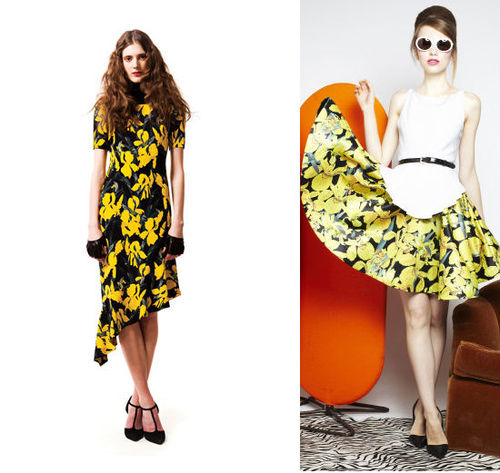This is the start of a series on the various types of law that fashion designers have to protect their work/designs. This first post will be a brief overview of what legal protections are currently available and the required legal standards. I will briefly introduce trademark, patent and copyright as the major sources of law that governs the fashion world.
Trademark protection is what many designers will use to protect a word, symbol or phrase used to identify their merchandise. Courts have even extended, in some circumstances, protection beyond the word/symbol/phrase to that of aspects of a product, such as color. This is more commonly known as trade dress. So for example, Christian Louboutin is known for their red soles on the bottom of their shoes/heels and has recently acquired trademark protection for that aspect.
 However, trademark law only protects a designer’s mark from infringement if another company were to create a similar mark. The similarity would have to cause a likelihood of consumer confusion. Further, in order to bring an infringement suit, the designer would have to claim a valid common law right by being the first to use in commerce, or would have to be the first to register their mark with the U.S. Patent and Trademark Office. Many designers face the issue of their designs being replicated, but trademark law would not cover this area. However, trademark law does assist with one major area, counterfeiting. The problem with counterfeiting litigation is ensuring that counterfeit production and sales actually cease. Its not to say a victory is not possible, but a fashion designer or house seeking protection needs to be able to name the company sending the shipments of counterfeit goods to be most effective.
However, trademark law only protects a designer’s mark from infringement if another company were to create a similar mark. The similarity would have to cause a likelihood of consumer confusion. Further, in order to bring an infringement suit, the designer would have to claim a valid common law right by being the first to use in commerce, or would have to be the first to register their mark with the U.S. Patent and Trademark Office. Many designers face the issue of their designs being replicated, but trademark law would not cover this area. However, trademark law does assist with one major area, counterfeiting. The problem with counterfeiting litigation is ensuring that counterfeit production and sales actually cease. Its not to say a victory is not possible, but a fashion designer or house seeking protection needs to be able to name the company sending the shipments of counterfeit goods to be most effective.
Another major area of law that affords some protection to fashion designers is that of patent, more specifically design patents. A design patent protects the way a useful product looks, but does require that the article be “new, original and ornamental.” The legal standard is not an easy one to meet or else every designer could acquire one. There is also the issue of the timing involved in acquiring a patent as it could take up to a year or more. Fashion is all about what is in demand or trendy for a given season, so a designer would have to ask about the longevity of a given design and is the cost and time worth it? There is also an issue of actively protecting what has been patented. A court would have to find similarity in the product allegedly infringing a patented design. All in all, a design patent can be quite difficult to acquire and is not an automatic guarantee of protection depending on the scope of the issued patent.

Stella McCartney‘s recent design patent on this sheered cut-out polka dot dress
Finally, there is the area of copyright law. Currently, copyright law does not afford the best protection for designers to disallow others to replicate their designs. There are 2 main reasons for this. One, is that copyright law requires originality; with fashion, it is difficult to create a design that is sufficiently original to prevent others from creating one that is strikingly similar. Generally in fashion, one is being derivative of a concept or design that has come before. The second copyright limitation is that a design would fall under the copyright category of a pictorial, graphic or sculptural work. Copyright protection is only granted for this area when a design incorporates features that can be identified separately from and are capable of existing independently from the utilitarian aspects of the article. Generally, when courts analyze cases involving copyright over clothing, its found that the garments are utilitarian by covering a wearer’s body. If however, the design can exist separately and does not lend to the utilitarian aspect of clothing then a grant of copyright protection is possible.

Recent accusation of Alice & Olivia (on right) copying design of Vena Cava (left)-likely would not qualify as copyright infringement
Just as in other areas, a designer would have to take necessary actions in order to protect their copyrighted works. Generally, making sure the work has been registered with the Copyright Office is of the utmost important. If there is a claim of infringement, then upon any cease and desist letters not working, legal action would have to be pursued.
There are a lot of possibilities that have been discussed for how fashion designers and the like can protect themselves and their work. My final piece in this series is to find out what current designers in the industry feel about the laws-are they sufficient, what more could be offered, or how would they like to see a law written to best protect their hard work? I am going to be reaching out to attain and analyze these responses, but in the meantime I will address each of these areas a bit more depth by looking at recent cases and discussing the application of the law and any issues that remain. So keep an eye out for the next piece in this series and that will be on trademark law!
Related articles
- Design Patents. An Unused Gem of IP Protection. (artlawjournal.com)
- Should You Consider a Design Patent? Pt. 1 (artlawjournal.com)
- The Surprise Leader in Design Patents (forbes.com)
- Design Patents and the Pretzel Patent Troll – Sweeny Legal (sweenylegal.com)









Pingback: The Hollywood Hills Burglar Bunch-The Legal Backdrop | Fashion Nexus
Pingback: The Kardashian Cosmetic Brand Legal Battle Ensues-Will Their New Mark Be Granted Federal Trademark Protection? | Fashion Nexus